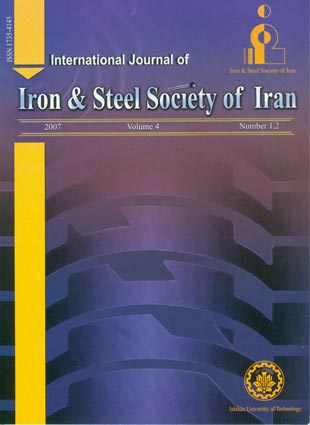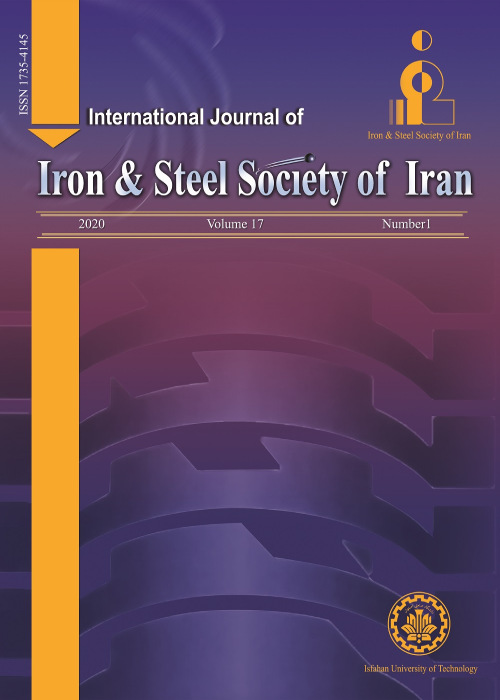فهرست مطالب

International Journal of iron and steel society of Iran
Volume:4 Issue: 1, Summer and Autumn 2007
- 56 صفحه،
- تاریخ انتشار: 1387/02/20
- تعداد عناوین: 8
-
-
Page 1Obtaining temperature distribution data of slabs under rolling is essential as the mechanical and metallurgical properties of the metal under this process vary with temperature. Using the control volume method, a mathematical model is employed in this study to predict slab temperature in the ho t roll process at Mobarakeh Steel Company. The effects of different parameters including the heat resulting from p lastic deformation and slab material are investigated. Additionally, heat conduction along the rolling direction in the slab, ignored in mo st previo us studies, is included in our investigation. The study indicates the importance of this term in the accuracy of the results obtained.
-
Page 8The liquid metal flow and the solidificatio n behaviours in a multi-cavity casting mould of two automo tive cast parts were simulated in three dimensions. The commercial co de, FLOW-3D® was used because it can track the front of the molten metal by a Volume of Fluid (VOF) method and allows complicated parts to b e modeled by the Fractional Area/Vo lume Obstacle Representation (FAVOR) method. The grey iron automo tive components includ ing a brake disc and a flywheel were cast using an automatic sand casting production line. For simulation analysis, the solid models of the casting, the gating system and the ceramic filter were spatially discretised in a multi-block pattern. The surface roughness and the contact angle of the mould were taken into account in the model, based on the prop erties o f the sand mould used. The turbulent flow was simulated using the k- turbulence model. The Darcy''s law was used to analyse the fluid flow throughout the ceramic filter designed in the gating system. Proper bo undary conditions were assigned for the model so that b oth the simulated filling time and the solidification time were achieved in the range of real experimental measurements. The predicted hot spot of the castings were in agreement with experiments. The verified simulation model showed that the four-cavity mo uld used fo r the flywheel part is more suitable than the three-cavity one o f the brake disc, in getting a more uniform fluid flow and heat transfer conditio ns which causes similar cast parts in each mould. The simulated flow pattern during the mould filling of the castings showed that the first gate of the gating system is not working properly as it remains partially-filled (not pressurised) throughout the half of the filling stage, causing a possible air absorption by the melt. A smaller cross sectional area for the first gate was sug gested. The present simulation model is ab le to analyse different casting parameters of the automatic multi-cavity sand casting process.
-
Page 16The aim of this study is to investigate the nucleation of new grains by necklacing mechanism during dynamic recrystallization (DRX). The material used is 3 16 stainless steel. In order to modeling the defo rmation behavior during hot ro lling, one-hit compression tests were performed at temperature range of 950 -1100 °C with strain rates of 0. 01-1s-1. The result shows that at the temperature of 10 00 °C with the strain rate of 0.1 s- 1, DRX developed by necklace mechanism, it is far from completeness over the steady state stress. By contrast the hardness increased by development o f DRX. The final microstructure is very heterogeneous and comprises of very fine and coarse grains due to the occurrence of partial DRX. The results also show that the necklace structure developed by increasing Zener-Hollomon parameter (Z).
-
Page 24Determination of critical points on hot stress-strain curve of metals is crucial in thermo-mechanical processes design. In this investigation a mathematical modeling is given to illustrate the behavior of metal d uring hot deformation processes such as hot rolling. The critical strain for the onset of dynamic recrystallization has been obtained as a function of strain at the maximum stress. In addition, the transition strain from static recrystallization to full metadynamic recrystallization has been presented to form an equation as a function of peak strain, peak stress and steady-state stress. The results of this mathematical modeling are in a good agreement with the experimental data.
-
Page 28A proposed method for protecting carbon steel and hence reducing iron release in an aqueous solutio n saturated with H2 S is presented in this paper. The method is based on forming a stable and resistant sulfide layer (pyrite, FeS2, or pyrrhotite, Fe(1- x)S, phase or a mixture of both) on the carbon steel surface. The study on the formation of the sulfide layer was carried out considering the effects of exposure time and surface status of the steel samp les under conditions of static solution saturated with H2S. The sample weight was measured and the chemical composition of the sulfide layer produced was analyzed using the XRD (X-ray diffraction). The crystalline structure was identified by SEM (Scanning Electron Microscope) and EDAX analysis. The results showed that after a 12-d ay exp osure time at a pressure of 15.7 bars and temperature of 13 0 oC, a passive layer including the p yrite phase was formed on various samples. In addition, the acid citric washed samples enjoyed a mo re coherence and layer thickness as compared other samples that had a different surface conditio n.
-
Page 34The AISI 316 L Stainless Steel (SS) specimens were exp osed to passivation surface through two different processes including; holding in 40-vol% HNO3 at temperature o f 60 C for 30 min and 15-vol%H2 SO4 at ambient temperature for 1 hour. The corrosion behavior of specimens was evaluated in physiological solutions by electrochemical in vitro tests through linear and Tafel polarization tests. Cyclic polarization tests were performed for investigating of the sp ecimen’s resistance against pitting. Finally, the corrosion resistance of untreated and modified specimens was compared. The results show that the corrosion resistance of 316 L SS metallic implant is increased due to passivation surface treatment.
-
Page 39The current work was carried o ut to characterize welding of AISI 3 10 austenitic stainless steel to Inconel 657 nickel-chromium superalloy. The welds were produced using four typ es of filler materials; the nickel-b ased corresponding to Inconel 82, Inconel A, Inconel 617 and austenitic stainless steels 310. Of the two joints involved, this paper describes the choice of welding consumables for the joint. The comparative evaluation was based on hot cracking tests (Varestraint test) and estimation of mechanical p roperties. While Inconel A exhibited the highest resistance to solidification cracking, the Inconel 617 filler material also showed moderate resistance and in addition, the latter was superior from the mechanical properties view-points. It was concluded that for the joint between Inconel 657 and 310 SS, the Inconel A filler material offered the best compro mise.
-
Page 50This paper describ es the work done between IUST and two Iranian steelworks to evaluate and review the performance o f mould fluxes in current use for continuous casting. Calculations have been performed to compare actual values of powder consu mption, viscosity and break temperature of the fluxes in current use with required values derived fro m published empirical rules for casting conditions. It has been found that there is, in general, p oor agreement between actual and required values. The required viscosities of mould fluxes consumed in MC grades are 2.2 and 1.9 dPas while the measured values are 1.5 and 1. 1 dPas, respectively indicating higher values. This situation is reverse in LC grades, and actual viscosities are lo wer than the measured values based o n empirical rules. There is also a d isagreement between the carbon content and break temperature of the current fluxes and required values resulting in the defects in produced slabs. These differences are more critical in MC grades.This does not necessarily mean that fluxes are not working well but do es imply that a review of mould flu x performance is needed before the planned increases in production are implemented. One steel company experienced problems with overflows of steel (bleeds) and with depressions in the surface of the slab. Possible reasons for the formation of these defects are proposed.


